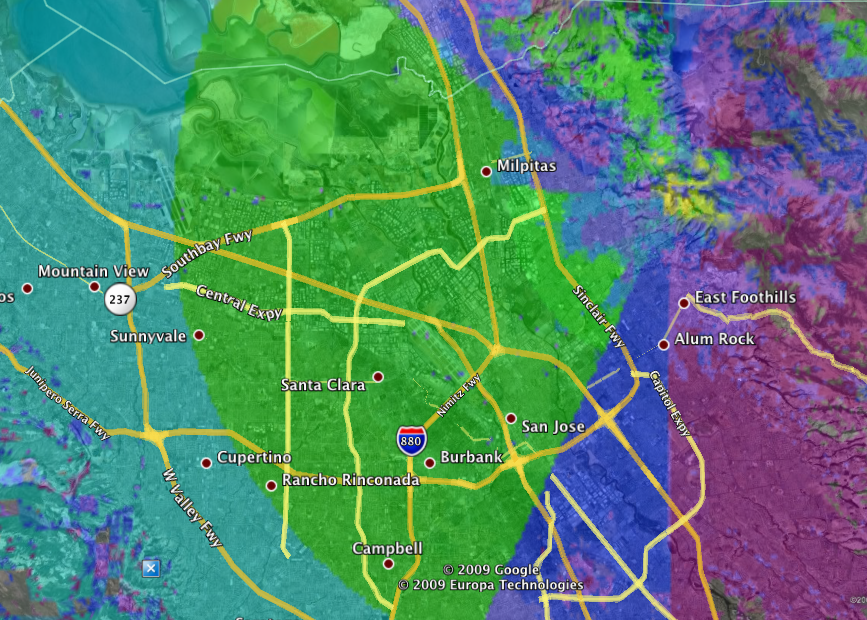
| Our Coverage area |
|---|
 |
Note The repeater is not yet on the air. All the parts have arrived, however, so it should be up and running by the end of January, 2010. Here's a video of the first repeater bench test:
Stay tuned to my blog for details!
The repeater is located in the foothills East of San Jose, CA at about 1400 feet ASL. The repeater transmits ATSC compatible video from 909-915 MHz with about 75 watts of ERP, and receives DVB-S on a 6 MHz wide channel on 23cm (1264-1270 MHz).
The system is open to any and all users. Apart from FCC Part 97 rules, there are no other special requirements for anyone to participate. If you're crazy enough to spend the kind of money it takes to get on the air with D-ATV, well, we'd love to see you!
Set your downconverter for the 909-915 MHz channel (channel 1) and set your ATSC receiver for TV channel 3. Depending on your receiver, you may need to rescan while the repeater is actively transmitting.
The repeater doesn't have an MPEG encoder - it relies on its users to provide a proper MPEG transport stream. Unfortunately, most of the time the transport stream being sent won't be in absolutely strict compliance with the ATSC specifications. Most users' transport streams will contain MPEG2 audio rather than AC3, which means your tuner / TV may not be able to decode the audio. Most users' transport streams will also be missing ATSC-mandated PSIP tables. Despite that, most TVs and tuners are able to at least display the video, and most TVs can decode the non-standard audio as well. Of course, tuners intended to be computer peripherals, such as the HD HomeRun, simply present the entire transport stream to the computer for processing, which makes them the most resiliant.
In order to make reception easy and consistent for our viewers, we recommend using standardized PIDs in your transport stream. Doing this will save viewers having to rescan every time someone else transmits through the repeater. For MPEG2 video, use 0x100; MPEG2 audio, 0x101.
Note also that nothing in particular requires there to be audio and/or video in any of these streams - so long as it is all formatted as a proper MPEG transport stream, it's good. Of course, if it's not audio and/or video, people watching on their TVs won't be able to do anything with it. Experimenting with advanced streams - such as H.264 encoding - is encouraged, but isn't very much fun for those of us watching with ordinary TV sets. As such, it's a good idea to include a low-bandwidth video stream to go along with any experimental data you transmit.
To estimate the effective radiated power you need to get into the repeater, use this chart. The chart was designed for 70cm, but it will work the same for the 23 cm input. The receive antenna is a Diamond X6000A, which has 10 dBd of gain on 23cm, but on 23cm, relative to 70cm, you incur a 9 dB receive penalty, and there's about 1 dB of feedline loss.
When the 70cm receiver is added, you'll be able to use the same chart, but add about 9 dB worth of receive system gain when using 70cm.
Here are the steps you need to perform to get up on digital ATV:
1. Get some video. This doesn't have to be live video, but that's usually what everyone wants to do. For most folks, it starts with a video camera of some sort. An NTSC security video camera or camcorder will do nicely. If you want to transmit in HD, well, you're on your own.
2. Encode it to an MPEG transport stream. You can do this with a computer, but not usually in real-time. Real-time MPEG encoders are not cheap. And particularly not if they're broadcast quality and include a Dolby AC-3 audio codec in them. If you don't require your encoding to take place in real-time, any PC can be used to make a stream suitable for delayed playback.
3. Take your MPEG transport stream and modulate it with a DVB-S exciter. You'll probably either buy one of these from SR Systems (see the vendor list below), or buy a pro one used somewhere. Generally, you'll wind up with about 0-10 dBm of power.
4. Amplify the exciter's output. This will mean an RF power amplifier, probably one from Downeast Microwave. The bad news is that digital TV requires absolute linearity in its amplifiers. So you must fit your signal entirely within the 1 dB compression point of the amp. But DVB-S has a 6 dB peak-to-average ratio. So if you want 10 watts of power, you must buy an amplifier whose 1dB compression point is at 40 watts. That probably means its saturated power rating will be somewhere around 60-70 watts. You must come to realize that you're going to have to way, way overspec your power amp for digital TV, certainly compared to AM or FM analog TV. Them's the breaks.
You can buy a pre-packaged exciter that includes an MPEG encoder that will generate either 1.5 watts of power on 70cm or 500 mW of power on 23cm from SR Systems for €700 (limit 1 per call-sign at that price).
It's worth noting that with a 30+ dB gain antenna (like a small dish), 500 mW of power should get you in from anywhere with a line of sight.
On 70cm, the symbol rate will be 3 megabaud, for a bitrate of 4.15 MB/sec.
Because the system will have multiple receivers, it will be able to support full duplex video QSOs.